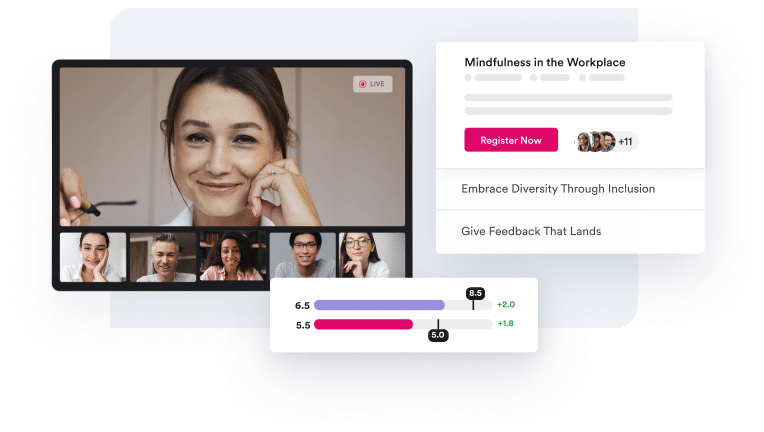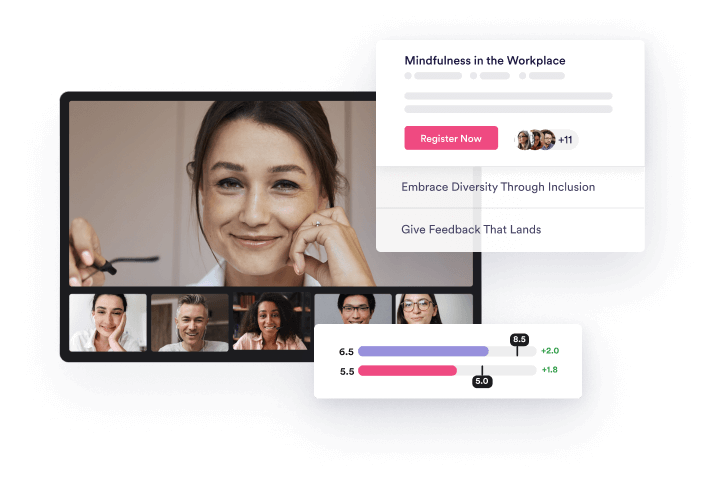Traditional career paths and “climbing the corporate ladder” are a thing of the past. Instead, employees want to feel valued at work and empowered to explore their strengths and opportunities to grow Employers of choice make the time and investment to create compelling career paths for advancement, including vertical, lateral, and cross-functional career moves.
There are many paths and strategies for implementing a workplace advancement program. But first, let’s explore ways to keep employees motivated and focused on career development within your organization.
Benefits of Career Path Development
According to research from Hays (a global recruitment firm), 4 out of 5 employees would leave their current roles if a better job offer comes along, and 71% are willing to take a pay cut for their ideal job. As a result, more competition exists for attracting and developing top talent, and companies who know how to establish a path to success for each employee will stand out from the crowd.
Each employee is unique and a fundamental asset to your company’s success and growth. Creating and communicating a vision for each employee’s exceptional value helps keep them engaged and inspired to commit to a mutually beneficial professional partnership. With considerate and encouraged career paths, your company should see benefits in higher productivity levels and job satisfaction from each individual.
HAplan to address each employee’s goals helps you plan for succession and filled seats for leadership potential. Why not invest now in high performers and those interested in improving their craft daily.?Does your organization have an up-skilling or leadership training program? Consider how your company is treating promotion and new role fulfillment.
If you see a high turnover rate and new positions billed by outside candidates, evaluating your training and career advancement practices might be time. A well-defined career path can be an attractive selling point for potential employees, especially those working for long-term career opportunities. This can help companies attract top talent and build a strong employer brand. In addition, setting a framework for each team’s career development programs is an excellent start toward holding your organization accountable and creating a positive work experience for each individual.
A Step-by-Step Framework for Creating Compelling Career Paths
Getting Started with Direct Reports
The first step in developing compelling career paths with each employee is to have an initial career conversation. If you are a manager, this is a time to level-set with each direct report. Uncover how their skills and potential are pursued and discover what they enjoy doing.
Also, don’t forget to consider and ask what they dislike about their current role or responsibilities. Honest dialogue around these topics give them ownership of their personal development and helps managers hear straight from employees without building their assumptions. For better career conversations, managers should keep an open mind to receive feedback and stay curious when asking questions to uncover career development ideas from each employee.
Important Career Questions to Ask Employees:
- What brings them joy, adds energy, and a sense of purpose from their current role?
- Which areas of their current position bring on boredom or disengagement?
- What future work environments and responsibilities are you seeking?
- Are there particular assignments or work you want to avoid in your career development?
- What factors could be blocking their career progress? And how can you help remove barriers?
Managers can get stuck in the daily grind and sometimes miss opportunities to capture feedback and connect personally with direct reports. Consistency is essential when scheduling and following through with career conversations with each direct report. Set clear expectations for how often you will meet to discuss your career path and what you expect each employee to bring to the conversation.
Organizations often build performance reviews yearly to check employee development and discuss advancement and learning opportunities. While this might be the current setup for your team to talk career moves, it’s encouraged to have more check-ins throughout the year as employees set goals and evaluate their own success and job fulfillment.

Career Path Conversation Follow Up
- Discuss strengths and weaknesses from the direct report’s experiences
- Have regular one-on-one convos for measuring success, discussing frustrations, and managing roadblocks
- Host formal career check-ins every six months to a year to evaluate career move opportunities or adjustments to each career path
When employees feel heard, your team gets more robust, and psychological safety becomes an active component of your company culture. Organizations or managers can block employee development without transparency and make assumptions that each direct report wants to grow. You do not want to find out an employee is unhappy during an exit interview.
Employees who feel their managers are playing an active support role in their career, in alignment with business goals, build healthy room for growth and milestones to achieve together.
Align the Compelling Career Paths with the Needs of the Business
Once you’ve identified what interests are meaningful for each employee, put them on a path to success that can be measured. There is always an opportunity to change paths, re-evaluate a chosen path, or develop new branches of progression for their intended goals. Therefore, getting started and seeing where the course takes them along the way is essential while being available for support.
First, you need to align all employee career paths with the current needs of your business. Always filter each career move and employee responsibility update through a lens of overall company health regarding financial stability, retention, team dynamics, and upskilling opportunities. Your leadership team should help guide the company’s vision and communicate urgent and long-term needs for profitability and continuous improvement.
When employees have a clear path for career advancement, they are more likely to seek out opportunities for skill development and professional growth. This can lead to a more skilled and knowledgeable workforce. In turn, those employees who sustain a positive experience are the best influencers for referrals and growing your team.
Build Clarity into Each Career Path
Clarity is essential when working together on a career path for each employee. Sounds simple, right? But we all know this can get complicated with time constraints, personality differences, and communication styles. Managers who provide multiple ways to communicate and promote measurable performance indicators will have more success in defining improvement standards and new opportunities for promotion and increased responsibility.
Practically, this means giving each employee the information they needs to advance in their career. Discuss the options and opportunities for vertical, lateral, and cross-functional growth. Explain why each role matters and where you could see each employee fitting in a career map or accountability chart.
Creating a Compelling Career Paths Checklist
- Organizational chart with defined roles
- Skills and expectations for each role with time estimates for advancement
- Resources available to help in professional development
- Options for vertical, lateral, or cross-functional moves (move forward, then move up)
- Growth options for people managers and individual contributors
Once you’ve identified an individual’s growth opportunity, define what skills are necessary to achieve performance goals and own new responsibilities that come with a change. From there, you’ll need to acknowledge the available resources for the employee to develop those skills.
There are often training and learning programs to support personal development, or the employee may know what external education they would like to pursue. Get specific when managing expectations and ways to propel your direct report career forward. Depending on how long each employee has been a team member or the length of time in a specific role, there should be distinguishable ways to accelerate their journey in your company and their professional networks. Here are a few path accelerators to consider for each employee.
Career Path Accelerators for Managers to Implement
- Grow people’s skills by giving them projects slightly outside of their comfort zones
- Make introductions to key people – other leaders, mentors, role models
- Encourage direct reports to build professional networks
- Pay for people’s development, or they’ll find a place that will
- Talk to HR, People Ops, or leadership about requirements for promotions,
salary increases, and other moves
Removing Bias from Career Path Development
Managers must identify and remove bias when seeking direct report movement and advancement. Bias can show up in many ways for managers, and it’s important to be alert when your own bias comes into play or is called out by other colleagues.
For example, without clear guidelines on how employees are evaluated for promotion, affinity bias can exist between managers and direct reports. This bias exists when favoritism can be shown between employees because “they click,” share common bonds, or maybe have relatable personalities or interests. Confirmation bias can also be a factor when managers have unclear expectations of what is required for career growth and not using accountability metrics for awarding new responsibilities or job promotions. This might include managers evaluating extra effort or inputs as a clear indicator for success, excluding other performance metrics or skillsets that team members have demonstrated for specific roles.
Many companies need to improve employee fairness and an equitable work environment. Unfortunately, many business professionals experience racial prejudices while at work. A Coqual study revealed how this could be broken down from specific populations that feel treated differently at work.
U.S. Professionals Who Have Encountered Racial Prejudice at Work
- 58% of Black Professionals
- 41% Latino Professionals
- 38% of Asian Professionals
- 15% White Professionals
To support an equitable work environment centered on solid DEIB principles, leaders should take the time and consideration to understand where they may be missing the mark. By removing bias from the career path process, managers will promote a more equitable culture that provides an opportunity for all employees.
How Can Managers Facilitate Compelling Career Paths?
Not all compelling career paths involve a new promotion for employees, but all employees should expect to progress in their careers within each company. To account for these personal goals, consider how to provide multiple ways for people managers and individual contributors to be allowed to take on new responsibilities or roles. Here are a few ways managers can promote an environment for personal growth and encourage career paths with various options in alignment with employee interests and business goals.
Vertical Career Moves
Vertical career moves are the most common for professionals to define and associate with personal and financial success quickly. Often, this move entails a promotion, a new title, more responsibility, and usually management of people. However, while many quickly seek this career move, the timing and circumstances must be right.
To enable vertical career moves, managers should find ways to accelerate progress through milestones before advancement. For example, managers conduct trial runs with candidates for vertical activities by giving them projects slightly out of their comfort zones. This way, they can assess performance, how this individual can take on a new role, and how they interact with direct reports. Mentorship is vital in this move – so try to find natural ways to identify role models within your company for this person to emulate the behavior and encourage the development of professional networking for new learning opportunities.
Lateral Career Moves
Lateral career moves can involve quite a few scenarios for team members. For example, employees could explore taking on a new role in a different department. Or, they could stay in their current department but push themselves to incorporate new responsibilities. One benefit of making a lateral move is exploring other options before committing to a vertical path. Also, vertical activities may not be available now, but each manager should motivate and keep employees engaged in their career growth.
Lateral moves are just as crucial as vertical and cross-functional and acknowledge that they can take on new functions and ownership of projects based on an employee’s interest and strengths. Some individual contributors might prefer this option as they see their value on the team or another department but do not enjoy managing people or taking on extra accountability with a direct vertical move.
Cross-Functional Career Moves
Cross-functional career moves are becoming much more prevalent in the workplace. The value individuals can offer to these defined roles is highly sought after because team members can bring together groups and ideas. Employees seeking cross-functional moves may play a role on multiple teams or as a facilitator between teams.
These individuals love balancing the communication and coordination between lines of business and departments to create team synergy. Being a generalist can be a great way for multiple teams to identify points of view and solve complex problems that require buy-in across the organization. In addition, employees who enjoy being the connection point between groups may showcase their skills for accepting a vertical career move shortly.
How to Enable Compelling Career Paths for Your Employees
Creating compelling career paths for each employee is vital to company growth, upward mobility, and a sense of accomplishment and value for each direct report. Managers who instill a clear and consistent plan for their employees to thrive will increase engagement, decrease turnover, and provide a work culture that identifies and corrects bias in their advancement programs.
Ask yourself – where is your organization in the process of each department leader owning the facilitation of career paths for their direct reports? Then, ensure your managers are equipped to be thoughtful in their career move evaluations and plans for success for each individual.
Hone empowers your leaders to participate in learning sessions and workshops from L&D industry experts. In addition, our learning and development coaches will help enable your team with the right mix for creating compelling career paths for all employees that align with your business goals.









